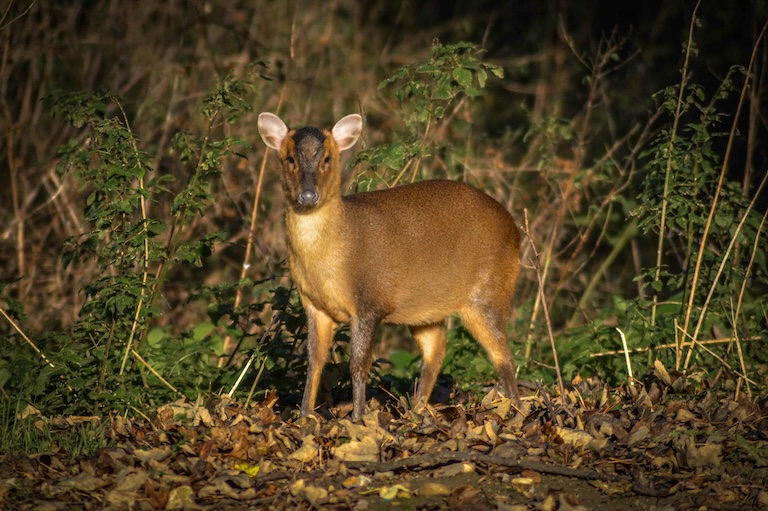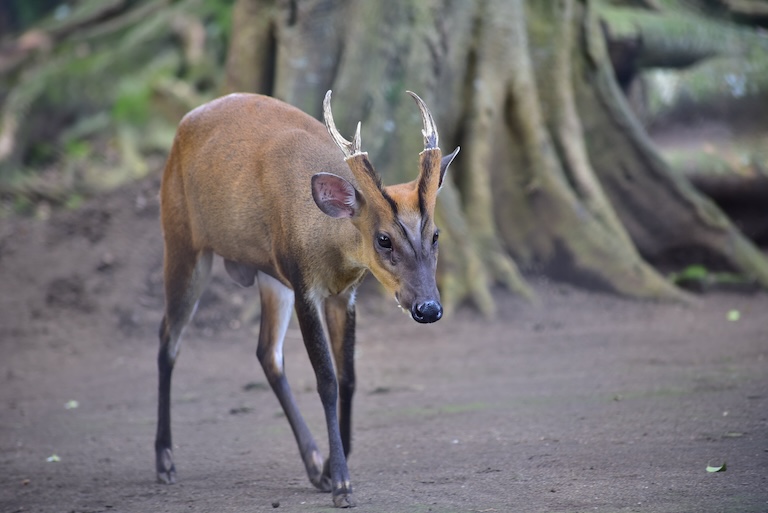Muntjac Profile
Until the turn of the 20th century, the smallest deer in the UK would have been the humble roe deer. This animal weighs a modest 30 kg, has classic deer antlers and makes a gentle squeaking sound and doesn’t have anything weird going on with it. Fine.
But then, an alien species from Asia was introduced, first as a curiosity, then as a feral population of tiny deer with fangs instead of antlers and the bark of a dog. And it’s been causing trouble ever since.

Muntjac Facts Overview
| Habitat: | Woodland, grassland |
| Location: | Native to South and Southeast Asia, invasive in the UK and Japan |
| Lifespan: | 13 years |
| Size: | 90cm long, 40cm to 80 cm tall |
| Weight: | 15 kg to 50kg (110 lb) in large species |
| Colour: | Fawn to red-brown |
| Diet: | Omnivorous: leaves, eggs, carrion, insects, birds |
| Predators: | Foxes, wolves, dogs, leopards, tigers, jackals |
| Top Speed: | Unknown |
| No. of Species: | 14 |
| Conservation Status: | Least Concern to Critically Endangered (IUCN) |
Muntjacs are a genus of relatively small deer found almost exclusively in Asia, except for one species that’s now invasive in the UK.
They’re mostly solitary, or found in small groups, and have a more primitive competitive weapon in the form of fangs, which in most species replace the rather limited antlers.
They range from the petite to the medium-sized and are sometimes known as barking deer on account of their strange calls. They are good breeders, and opportunistic feeders, sometimes even taking food most wouldn’t associate with deer at all.
Interesting Muntjac Facts
1. They’re small
Muntjac deer or some of the smallest deer in the world. At the very best they can just about grow to 80 cm tall, but this is in the species known as the giant muntjack, which goes to show the reference points we are dealing with.
There are in fact 14 species of this deer, perhaps the smallest of which is the Annamite muntjac, one of the smallest species in the world at around 15 kg and 40 cm tall. Put this in perspective, the pudu, often regarded as the smallest deer species in the world, stands somewhere between 32 and 44 cm tall.
So, these are very small deer, except when they’re not.

2. Except for the big ones
Of the 14 species, there are none larger than the so-called giant muntjac. These relatively colossal beasts boast an epic shoulder height of 80 cm and a formidable 50 kg of bulk in particularly powerful individuals.
This species has a red-brown coat and much bigger antlers than most of its siblings in the genus, giving it the other name “the large antlered muntjac”. 1
3. They’re fanged
Most species can’t boast such ornate cephalic attributes and have to make do with relatively small antlers. As seen in other species with this problem, these months commonly have tusks. These tusks grow to 6cm long and can be seen protruding out of the mouth, down from the upper jaw.
This is thought to be the primitive form of deer, predating the evolution of antlers, and used in very much the same way: as a weapon of competition.
And this is how the muntjacs use them. Males will fight for territory and mates using more of their teeth than their antlers, and they will do so at all times of the year.
4. They breed all year round
One of the strengths of these animals comes from their ability to reproduce whenever they feel like it. Rather than a strict mating season, muntjacs mate at any time of the year, although the male’s testes are less productive during the Summer.
This is quite an advantage for a solitary deer in a large habitat, as they never know when they’ll come across an opportunity to get their end away. 2
5. They bark
One way to improve the odds is to yell into the forest. But, being small dear, they don’t have quite the grandeur of their loudly bellowing relatives. Still, muntjacs I’m very vocal little cervids.
They can be heard barking at all times throughout the day and night, and at least two species are recognisable for these calls.
Reproductive calls are more shrill than alarm calls and sound more like a dog whose toe has just been stepped on.
This is a sound, that until the return of the 20th century, would’ve been purely restricted to Asia but is now quite common throughout the UK. 3
6. They’re invasive
A Chinese species of Munjac was brought to a Safari Park in England around the year 1900. The Reeve’s muntjac possibly remained captive for about 25 years before it figured out how to push through the fence and quickly colonise the country’s woodland.
It is now common across the southeast of the country and has put pressure on various local Flora and fauna.
The species is still expanding across the country and has made its way to the north where it continues to grow and is considered a pest and invasive species. 4

7. They kill
There’s a growing acceptance in the world of zoology, that animals refuse to be strictly categorised by their diets. The order Carnivora contains huge brutes built solely on bamboo shoots, and likewise, the world of herbivores is riddled with examples of murderous meat eaters.
Confused hunters and wildlife enthusiasts are catching up with the scientific consensus that there are very few exclusively herbivorous animals, and so it is: the tiny fanged muntjac is becoming known as an opportunistic killer of birds.
While their diet primarily consists of plant matter, very few herbivores will turn down the easy protein of a meaty meal when offered it, and the muntjac is no exception here.
They will eat eggs, nestling birds, and even small mammals if they can get their teeth on one, which makes the UK population even more daunting as an invasive species – not only are they competing with other native wildlife, but they’re actively killing them, too. 5
Muntjac Fact-File Summary
Scientific Classification
| Kingdom: | Animalia |
| Phylum: | Chordata |
| Class: | Mammalia |
| Order: | Artiodactyla |
| Family: | Cervidae |
| Genus: | Muntiacus |
| Species: | cervus muntjak |
Fact Sources & References
- “Large-antlered Muntjac”, World and Trust.
- “Reeves’ muntjac deer”, Wildlife Online.
- “Barking Deer Sounds & Calls”, Wild Ambiance.
- “Muntjac deer”, The Wildlife Trusts.
- “Reeves’ Muntjac”, Columbus Zoo.
